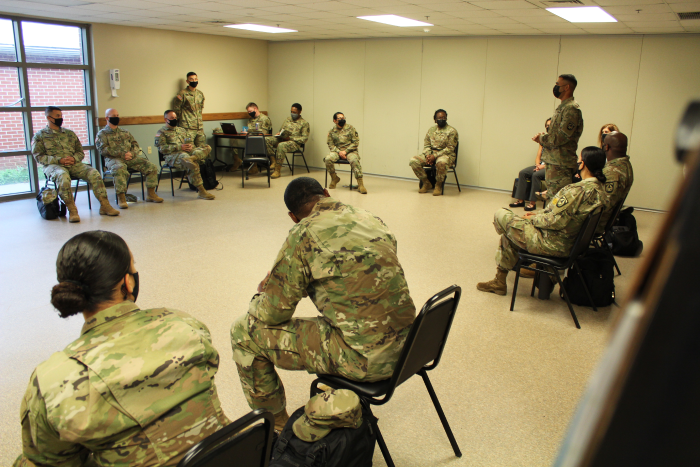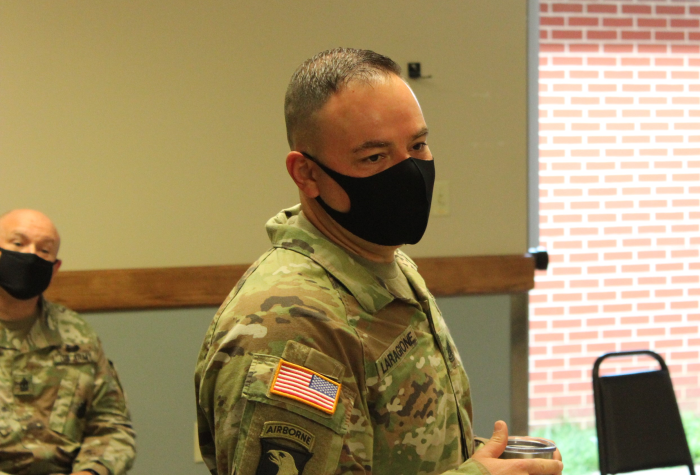USAMRDC Seeks Solutions to Eliminate Sexual Harassment, Assault

The U.S. Army Medical Research and Development Command gathered a small group of Senior Enlisted Leaders from across the command for a three-day off-site event beginning on September 14. While most SEL events are chiefly centered around training and mentoring sessions, the current event is specifically designed to develop a plan to eliminate incidents of sexual harassment and sexual assault within the command.
“Many will say, ‘that’s impossible, you can’t eliminate it,’ – and I say one is too many,” said USAMRDC Command Sergeant Major Victor Laragione in an interview prior to the event. “Let’s get outside of the box in terms of what we’ve always done and how we’ve always done it before.”
To that end, Laragione has established a two-pronged approach for the assembled Soldiers – a group that numbers slightly more than a dozen in total – to reach his desired outcomes. The first effort (or “track”) will involve developing both an overarching plan of action and a complementary list of individual milestone achievements to gauge progress in eliminating such behavior from the command. The second track will involve strengthening USAMRDC’s Sponsorship Program to help improve the introduction and integration of every Soldier, contractor and government employee into the command in a manner that highlights the tenets of the aforementioned action plan. Such efforts dovetail with recent and increased attention on sexual harassment and sexual assault by the Department of Defense.
“The DOD is already empowering people like me to have these conversations,” said Maj. Karmon Dyches, Military Deputy for USAMRDC’s Military Operational Medicine Research Program’s Psychological Health and Resilience Program Area and a moderator for track number one. “This is a systemic cultural issue – it isn’t just a thing that happens in dark alleys among strangers.”
Formerly stationed at the DOD Sexual Assault and Prevention Office, Dyches speaks with a substantial amount authority on the issue. She sees her role in the off-site event as a facilitator more than anything else; giving the assembled group the material and data they need to cover the required ground. In her view, such efforts at the command level serve as a supplement to the headway DOD leadership has made in recent years in addressing said issues. Army-based Sexual Harassment/Assault Response and Prevention courses are now given at the unit level in smaller, more personal settings as opposed to the larger, auditorium-sized settings of years past. According to Dyches, the change encourages greater line-level leadership engagement and accountability.

“I would love it if they could solve this entire problem on a Tuesday,” said Dyches of the group’s sizable task. “But they can start an upstream dialogue that will hopefully have trickle-down effects that might help someone down the road.”
Helping to moderate the track designed to strengthen USAMRDC’s Sponsorship Program is Sandy Snyder, manager of both the Military Burn Research Program and the Battlefield Resuscitation and Immediate Stabilization of Combat Casualties Portfolio at the Congressionally Directed Medical Research Programs. As a critical care nurse in the Army Reserve – indeed, she’s been serving in that capacity for 24 years – Snyder brings a level of both professional and clinical experience to a moderator role integral to the overall output of the meeting.
“It’ll be interesting to see what the SEL who are in the meeting offer up in terms of solutions,” said Snyder. “My job is to try and help them determine what the problems are and what those solutions can be.”
While designed to be a fully-encompassing leadership training event – and set to include several other different and engaging team-building events – the overall focus of the meeting remains clear: finding a suitable pathway forward in eliminating sexual harassment and sexual assault from USAMRDC. For Command leadership, the effort continues in earnest.
“Let’s better understand what the current problems are, and identify where the greatest risks are,” said Laragione. “The question now is – what are we going to do about it?”














